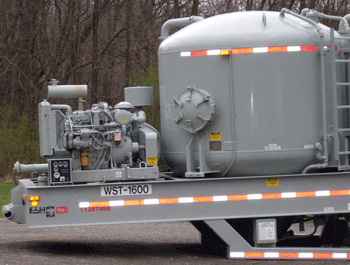Chemicals
From Wikimarcellus
| Revision as of 22:06, 28 May 2009 Tcopley (Talk | contribs) ← Previous diff |
Current revision Tcopley (Talk | contribs) (fracturing fluid) |
||
| Line 1: | Line 1: | ||
| - | <center>http://www.sonic.net/~tcopley/img/frac_chem_tank_sm.gif <br>'''[[Halliburton]] frac fluid tank'''<br>The ''2005 Energy Policy Act'' exempts companies <br>from disclosing the ingredients used to frac gas wells<br> | + | [[Image:Frac chem tank sm.gif|frame|right|<div align="center">'''[[Halliburton]] fluid tank'''<br>Photo credit -[http://donnan.com/ donnan.com]</div>]] |
| - | as required by the ''Safe Drinking Water Act of 1974.''<br>[http://donnan.com/ Photo credit - donnan.com]</center> | + | |
| - | Examples of (toxic) chemicals used in [[Hydro-fracturing]] include benzene, toluene, ethyl benzene and xylene. Their use obviously raises concerns. | + | Most [[fracturing fluid]] is made up of water and sand. Those '''chemicals''' used in it for [[hydro-fracturing]] are mainly non-toxic and reduce corrosion, retard bacterial growth and improve down-hole lubrication. In any event, they consist of less than 1/2 of 1% of the fluid. |
| - | When water samples are analyzed from well water or other sources, signs it is tainted with fracing fluid chemicals may include unusual readings on: | + | However, there are also examples of chemicals reported to have been used that are toxins and/or carcinogens. These include benzene, toluene, ethyl benzene and xylene. Their use obviously may raise public concern. For example, ''benzene'' is extremely dangerous in concentrations as small as one part per million. It is a known carcinogen. |
| + | |||
| + | Field service companies have voluntarily stopped using diesel fuel in fracturing fluids due to public concerns over it being a possible source of benzene contamination. | ||
| + | |||
| + | When water samples are analyzed from well water or other sources, signs that they may be tainted with fracing fluid chemicals include unusual readings on: | ||
| * alkalinity | * alkalinity | ||
| * aluminum | * aluminum | ||
| Line 16: | Line 19: | ||
| * specific conductivity | * specific conductivity | ||
| * sodium | * sodium | ||
| - | * total dissolved solids. | + | * [[Total dissolved solids|total dissolved solids]]. |
| + | |||
| + | The ''2005 Energy Policy Act'' clarified that hydro-fracturing was never regulated under the ''Safe Drinking Water Act of 1974'' (SDWA), and drilling companies have not been required to disclose the ingredients used to frac gas wells under SDWA. However, individual states have heavily regulated fracturing activities for decades. Frac chemicals have always been a matter for state regulation, and very few, if any, examples of drinking water contamination have ever been reported. That is not to say contamination issues never exist, yet rather appear quite minimal despite any [[Environmental concerns|environmental concerns]] to the contrary. | ||
| + | |||
| + | During 2010-2011, field service companies began introducing lines of biodegradable, non-toxic [[hydro-fracturing|fracing]] chemicals. [[Halliburton]] introduced a product called ''CleanStim'' made up of chemicals used primarily in food processing. [[Baker Hughes Oilfield Operations Inc|Baker Hughes]] began marketing a product named ''BJ SmartCare'' made up of substances used in toothpaste and condiments. [[Flotek Industries, Inc|Flotek]] tested a biodegradable product that used citrus products as a main constituent. Yet another company, [[Trican Well Service Ltd|Trican]] introduced ''EcoClean''. | ||
| ==== Resources ==== | ==== Resources ==== | ||
| - | PA Dept. of Environmental Protection “Summary of Hydraulic Fracture Solutions.” [http://www.dep.state.pa.us/dep/deputate/minres/oilgas/new_forms/marcellus/marcellus.htm] | + | PA Dept. of Environmental Protection (DEP), [http://www.dep.state.pa.us/dep/deputate/minres/oilgas/new_forms/marcellus/marcellus.htm Summary of Hydraulic Fracture Solutions.] |
| + | |||
| + | [[Category:Drilling practices]] | ||
Current revision
Most fracturing fluid is made up of water and sand. Those chemicals used in it for hydro-fracturing are mainly non-toxic and reduce corrosion, retard bacterial growth and improve down-hole lubrication. In any event, they consist of less than 1/2 of 1% of the fluid.
However, there are also examples of chemicals reported to have been used that are toxins and/or carcinogens. These include benzene, toluene, ethyl benzene and xylene. Their use obviously may raise public concern. For example, benzene is extremely dangerous in concentrations as small as one part per million. It is a known carcinogen.
Field service companies have voluntarily stopped using diesel fuel in fracturing fluids due to public concerns over it being a possible source of benzene contamination.
When water samples are analyzed from well water or other sources, signs that they may be tainted with fracing fluid chemicals include unusual readings on:
- alkalinity
- aluminum
- barium
- calcium
- iron
- hardness
- manganese
- pH
- potassium
- specific conductivity
- sodium
- total dissolved solids.
The 2005 Energy Policy Act clarified that hydro-fracturing was never regulated under the Safe Drinking Water Act of 1974 (SDWA), and drilling companies have not been required to disclose the ingredients used to frac gas wells under SDWA. However, individual states have heavily regulated fracturing activities for decades. Frac chemicals have always been a matter for state regulation, and very few, if any, examples of drinking water contamination have ever been reported. That is not to say contamination issues never exist, yet rather appear quite minimal despite any environmental concerns to the contrary.
During 2010-2011, field service companies began introducing lines of biodegradable, non-toxic fracing chemicals. Halliburton introduced a product called CleanStim made up of chemicals used primarily in food processing. Baker Hughes began marketing a product named BJ SmartCare made up of substances used in toothpaste and condiments. Flotek tested a biodegradable product that used citrus products as a main constituent. Yet another company, Trican introduced EcoClean.
Resources
PA Dept. of Environmental Protection (DEP), Summary of Hydraulic Fracture Solutions.


